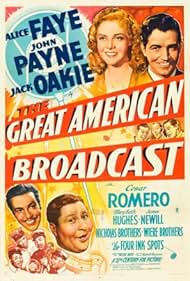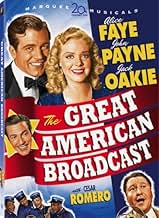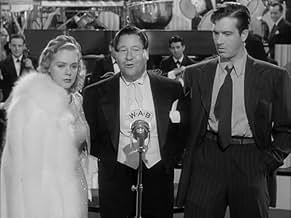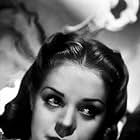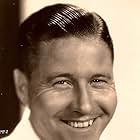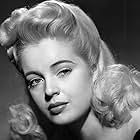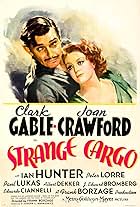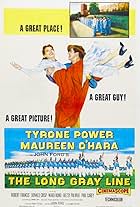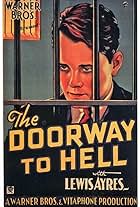After WWI two men go into radio. Failure leads the wife of one to borrow money from another; she goes on, after separation, to stardom. A coast-to-coast radio program is set up to bring ever... Read allAfter WWI two men go into radio. Failure leads the wife of one to borrow money from another; she goes on, after separation, to stardom. A coast-to-coast radio program is set up to bring everyone back together.After WWI two men go into radio. Failure leads the wife of one to borrow money from another; she goes on, after separation, to stardom. A coast-to-coast radio program is set up to bring everyone back together.
The Ink Spots
- The Four Ink Spots
- (as The Four Ink Spots)
The Nicholas Brothers
- Dancers
- (as Nicholas Brothers)
Fayard Nicholas
- Railroad Station Dance Specialty
- (as The Nicholas Brothers)
Harold Nicholas
- Railroad Station Dance Specialty
- (as The Nicholas Brothers)
The Wiere Brothers
- Dancers
- (as Wiere Brothers)
Harry Wiere
- Chapman's Cheerful Chappies
- (as The Wiere Brothers)
- …
Herbert Wiere
- Chapman's Cheerful Chappies
- (as The Wiere Brothers)
- …
Storyline
Did you know
- TriviaOriginal 1919 Jess Willard-Jack Dempsey fight film footage used.
- GoofsAlthough the story takes place in 1919, and the years immediately following, all of Alice Faye's clothes and hairstyles are strictly in the 1941 mode, as are also those of Mary Beth Hughes and the other female members of the cast; the musical arrangements of Faye's featured songs are also in the contemporary 1941 style.
- ConnectionsFeatured in Take It or Leave It (1944)
- SoundtracksThe Great American Broadcast
Music by Harry Warren
Lyrics by Mack Gordon
Sung by a chorus during the opening credits
Performed by James Newill and a chorus
Featured review
The Great American Broadcast marks the first of four films that Alice Faye teamed with John Payne at 20th Century Fox. It has long been a contention of mine that Payne was signed by Darryl Zanuck because he looked a whole lot like Tyrone Power and could sing and thus carry his end of musical films with Alice, Betty Grable, June Haver, etc. Funny thing is when he left Fox, Payne abruptly stopped doing musicals and concentrated on all kinds of other films. He never sang a note on screen after 1946.
Putting it mildly this is not the history of the origin of commercial broadcast radio. Still it's a pleasant 90 minutes or so of musical entertainment with Alice Faye, John Payne, Jack Oakie, the Ink Spots, the Wiere Brothers, and the tap dancing Nicholas Brothers. I won't even quibble about how one enjoyed the Nicholas Brothers tap dance on radio.
In 1919 flier John Payne, radio electrician Jack Oakie, saloon singer Alice Faye, and millionaire Cesar Romero essentially all team up to launch commercial radio. If you're wondering what Payne's specialty and what he brought to the table, he was the promoter of the bunch, a role he would repeat in Tin Pan Alley and Hello Frisco Hello also with Faye and Oakie. Alice has all three of these guys panting for her, but her heart belongs to Payne even though he's a bit of fathead and doesn't appreciate what he has.
Harry Warren and Mack Gordon wrote the songs for The Great American Broadcast, the best of which is I Take To You which should have done a whole lot better in record sales. Oakie has a very funny bit trying to fake an operatic tenor during an early broadcast.
The event which launches the quartet in the broadcasting business was the famous Jess Willard-Jack Dempsey heavyweight championship fight and director Archie Mayo did a very good job integrating newsreel footage of the fight with the cast. In the opening montage you'll also see a whole lot of radio personalities who were big in 1940.
As Alice Faye is one of my real favorites I'm prejudiced, but The Great American Broadcast holds up very well after over 70 years even if it isn't the history of radio.
Putting it mildly this is not the history of the origin of commercial broadcast radio. Still it's a pleasant 90 minutes or so of musical entertainment with Alice Faye, John Payne, Jack Oakie, the Ink Spots, the Wiere Brothers, and the tap dancing Nicholas Brothers. I won't even quibble about how one enjoyed the Nicholas Brothers tap dance on radio.
In 1919 flier John Payne, radio electrician Jack Oakie, saloon singer Alice Faye, and millionaire Cesar Romero essentially all team up to launch commercial radio. If you're wondering what Payne's specialty and what he brought to the table, he was the promoter of the bunch, a role he would repeat in Tin Pan Alley and Hello Frisco Hello also with Faye and Oakie. Alice has all three of these guys panting for her, but her heart belongs to Payne even though he's a bit of fathead and doesn't appreciate what he has.
Harry Warren and Mack Gordon wrote the songs for The Great American Broadcast, the best of which is I Take To You which should have done a whole lot better in record sales. Oakie has a very funny bit trying to fake an operatic tenor during an early broadcast.
The event which launches the quartet in the broadcasting business was the famous Jess Willard-Jack Dempsey heavyweight championship fight and director Archie Mayo did a very good job integrating newsreel footage of the fight with the cast. In the opening montage you'll also see a whole lot of radio personalities who were big in 1940.
As Alice Faye is one of my real favorites I'm prejudiced, but The Great American Broadcast holds up very well after over 70 years even if it isn't the history of radio.
- bkoganbing
- Jun 29, 2011
- Permalink
Details
- Runtime1 hour 30 minutes
- Color
- Aspect ratio
- 1.37 : 1
Contribute to this page
Suggest an edit or add missing content

Top Gap
By what name was The Great American Broadcast (1941) officially released in Canada in English?
Answer